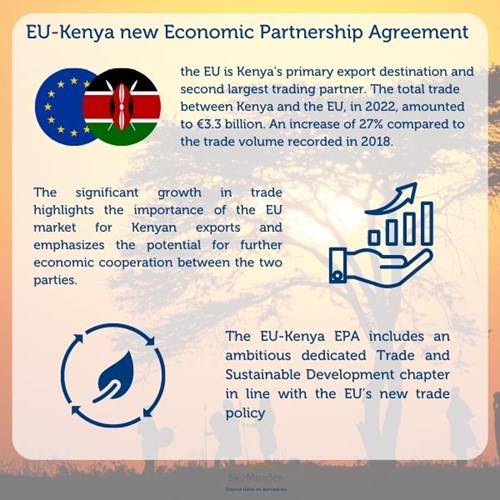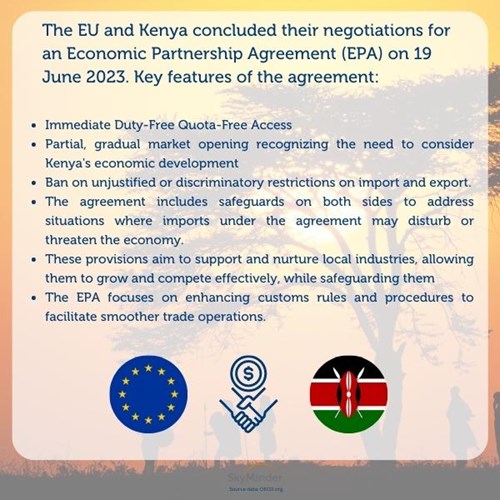Analysis and Studies - Studies
EU-Kenya Economic Partnership Agreement: an insight
June 20th 2023
EU-Kenya Economic Partnership Agreement
The European Union (EU) and Kenya have recently announced the successful conclusion of their negotiations for an Economic Partnership Agreement (EPA). This agreement holds great potential to enhance trade in goods and generate new economic prospects, with a specific focus on advancing Kenya's economic development. Notably, this trade deal stands out as the most ambitious EU agreement with a developing country in terms of incorporating sustainability provisions, including climate and environmental protection, as well as labor rights.
The negotiations were officially concluded in Nairobi, witnessed by Valdis Dombrovskis, the Executive Vice-President and Commissioner for Trade of the European Commission, and Hon. Moses Kuria, the Cabinet Secretary of Kenya's Ministry of Investments, Trade and Industry. The ceremony was honored by the presence of Kenyan President Dr. William Samoei Ruto.
 As Kenya's primary export destination and second largest trading partner, the EU has seen trade with Kenya amounting to €3.3 billion in 2022—a significant increase of 27% compared to 2018. The EPA will unlock even greater opportunities for Kenyan businesses and exporters by fully opening up the EU market to Kenyan products. Furthermore, it will encourage increased EU investment in Kenya by providing enhanced legal certainty and stability.
As Kenya's primary export destination and second largest trading partner, the EU has seen trade with Kenya amounting to €3.3 billion in 2022—a significant increase of 27% compared to 2018. The EPA will unlock even greater opportunities for Kenyan businesses and exporters by fully opening up the EU market to Kenyan products. Furthermore, it will encourage increased EU investment in Kenya by providing enhanced legal certainty and stability.
According to the European Union, Kenya has been at the forefront of sustainability efforts in Africa and has been a reliable partner in combating climate change. Earlier this year, Kenya, together with the EU, Ecuador, and New Zealand, took on the co-leadership of the Coalition of Trade Ministers on Climate initiative. Building on this impressive track record, the EU-Kenya EPA sets a precedent as the first agreement with a developing country to reflect the EU's new approach to trade and sustainable development. The agreement incorporates robust commitments on trade and sustainability, including binding provisions related to labor, gender equality, environment, and the fight against climate change.
 The EPA strikes a balance by considering Kenya's development needs, allowing the country a longer timeframe to gradually open its market and providing safeguards for agriculture, as well as protecting its developing industries. Moreover, the agreement features a dedicated chapter on economic and development cooperation, with the aim of boosting the competitiveness of Kenya's economy. Coupled with EU development assistance, this chapter will help strengthen Kenya's capacity and facilitate the smooth implementation of the EPA, while supporting local farmers in meeting EU standards and reaping the benefits that this agreement offers.
The EPA strikes a balance by considering Kenya's development needs, allowing the country a longer timeframe to gradually open its market and providing safeguards for agriculture, as well as protecting its developing industries. Moreover, the agreement features a dedicated chapter on economic and development cooperation, with the aim of boosting the competitiveness of Kenya's economy. Coupled with EU development assistance, this chapter will help strengthen Kenya's capacity and facilitate the smooth implementation of the EPA, while supporting local farmers in meeting EU standards and reaping the benefits that this agreement offers.
After the successful conclusion of the negotiations, the Economic Partnership Agreement (EPA) between the EU and Kenya will undergo a process of legal revision, commonly known as "legal scrubbing." This entails a detailed examination and refinement of the agreement's legal aspects. Following the legal scrubbing, the EPA will be translated into the official languages of the EU.
The European Commission will then submit the revised and translated agreement to the Council for signature and conclusion. Once the Council adopts the agreement, both the EU and Kenya can proceed to sign it officially. Subsequently, the text of the agreement will be forwarded to the European Parliament for consent, ensuring democratic oversight.
Upon receiving the Parliament's consent, the parties involved may choose to provisionally apply certain sections or provisions of the agreement, allowing for an early implementation of mutually beneficial aspects. However, the EPA will enter into full force and effect only after Kenya and the EU member states have ratified it through their respective internal processes.
This multi-step process ensures thorough legal scrutiny, democratic approval, and the ultimate implementation of the EU-Kenya EPA, solidifying the commitments and opportunities outlined in the agreement.
